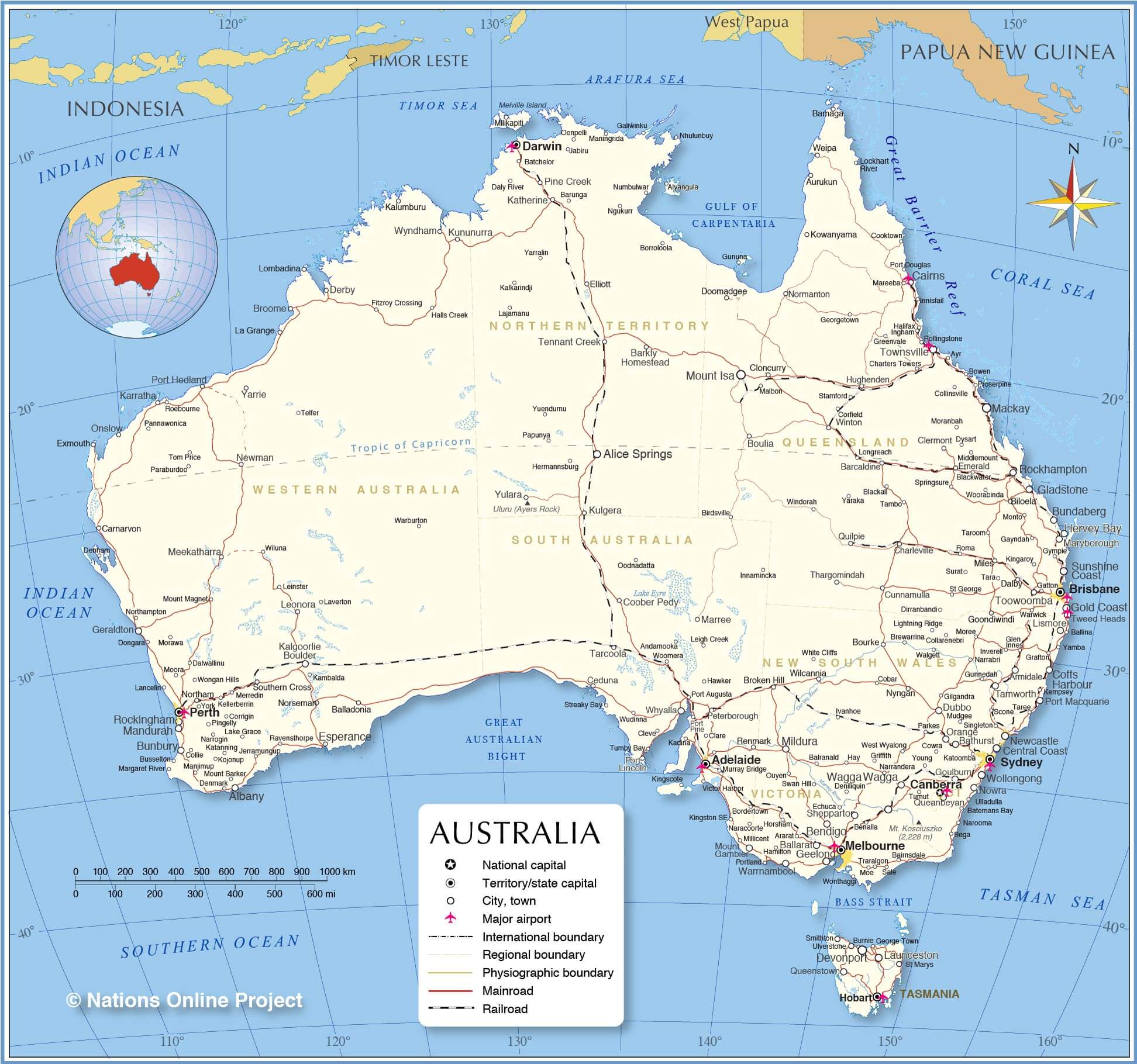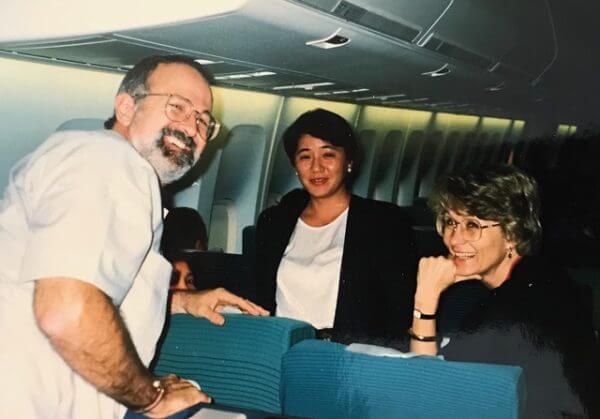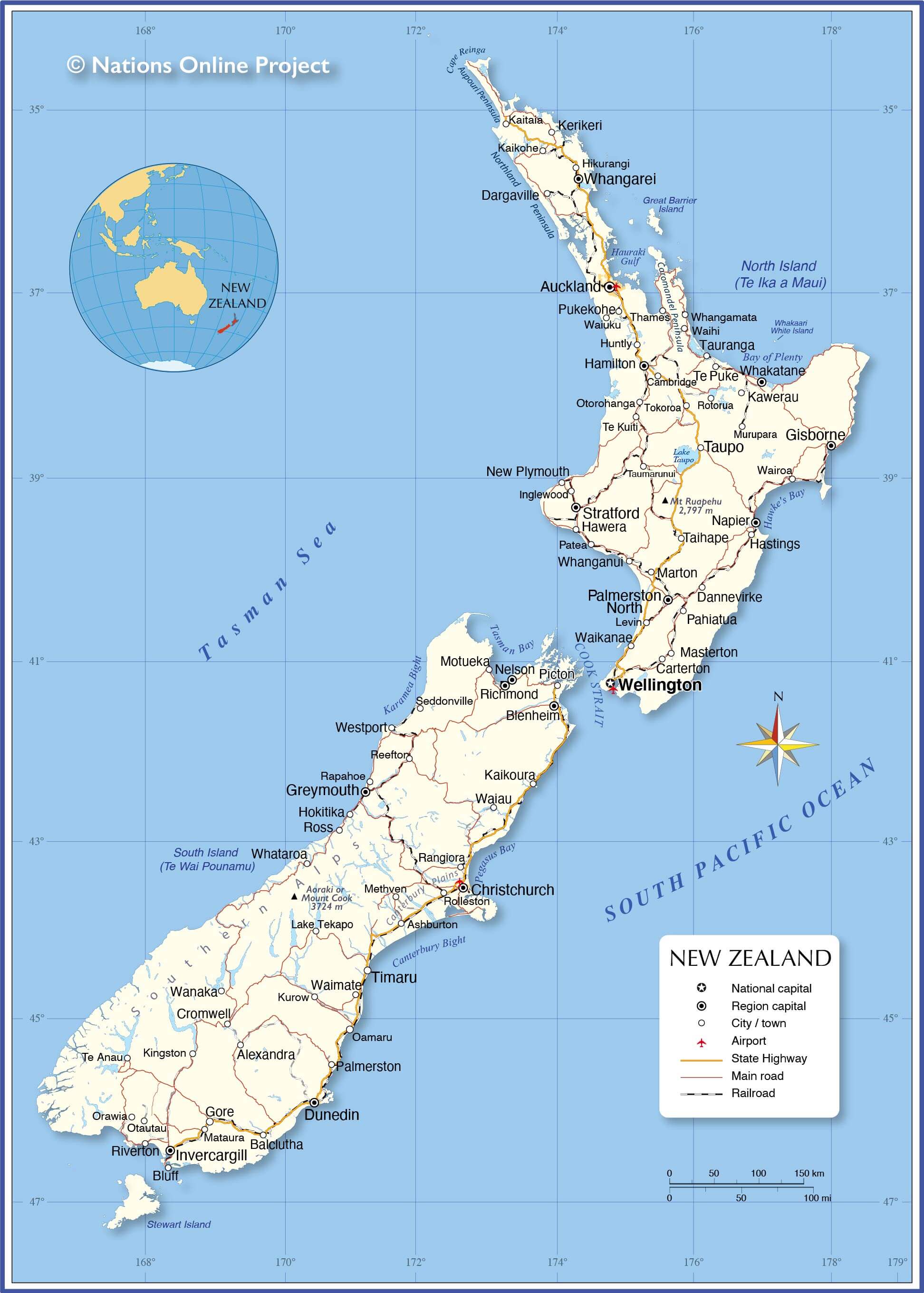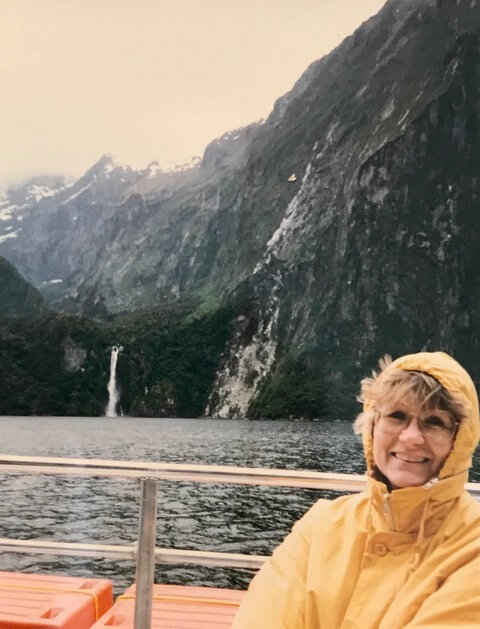#26: Touristing from Southeast AsiaAustralia and New Zealand
Russell’s UNDP Foreign Investment Advisory Project had borne fruit as his Lao Team moved from study tours in the region to organizing a conference in Sydney on investing in the Lao People’s Democratic Republic. I went along as a volunteer helper during the conference, and then we two added on a vacation in New Zealand. Here are excerpts from a long letter to family about this memorable trip. (You can click on maps and photos to enlarge them.)
November 23, 1992
After many adventures, we’re back home. It seems so long ago that we left.
I went down to Bangkok in late October, working with technicians to finish the photographic and computer-generated graphic slides for the audiovisual program about investing in Lao PDR.
On Sunday, November 1, the whole team flew from Vientiane, and I met them in the Bangkok airport with a sign of welcome written in Lao by a friend. We checked into the Airport Hotel, which gave us a royal welcome, complete with flower garlands for everyone and a complimentary tropical fruit drink in a special section of the lobby.
We stayed overnight and left early the next day on Qantas for Sydney. The flight was unremarkable except for its length. It takes a long time to get to Sydney from anywhere! We arrived at the Hyatt Kingsgate around 8 pm and had our first meeting with the team responsible for organizing the conference from the Australian side. To our dismay, we learned they hadn’t arranged facilities for simultaneous translation, despite our having requested it and brought a simultaneous translator.
When we tried to explain that such facilities were critical to any international conference, and especially to this one (e.g., the highest-ranking Lao speeches would be delivered in Lao), they said that this technology was quite new and not used very widely. Russell and Michael Mann (Australian Ambassador to Laos) politely disagreed and said it was standard procedure all over Asia, including poor countries like Laos. The Aussie team countered that the next day was the Melbourne Cup horse race and that the country would be shut down with no chance of finding such equipment. We had to proceed without simultaneous translation throughout the two days of the conference. The Minister’s speech was given in written translation to the participants so they could follow along as he spoke. Short speeches had sequential translation. We managed, but it was far from a world-class job.
This was just the beginning of many problems that we had with a most unprofessional and incompetent crew. [I won’t bore blog readers with all the details.] Ambassador Mann is making a formal protest to the Australian Government, recommending that this inept and combative government facility be shut down.
There were many, many incidents, so awful that Russell’s two assistants, one a sophisticated Lao and the other an experienced Japanese, became quite demoralized and formed extremely negative opinions of Australians in general. Australia’s policy is to become a Pacific nation, to be international in outlook, and a leader in the region. We met some really wonderful Australians, and all our team worked hard to remember these positive experiences. The problem is that some Australians haven’t really gotten with the program, and when they come in contact with foreigners, terrible impressions and results can occur.
Having said all this, let me not neglect to add that the conference itself was highly successful. Some 150 people came, leaders of Australian business and industry. The richest woman in Australia, the president of a major conglomerate, was the featured luncheon speaker, and her speech couldn’t have been more to our liking if we’d written it ourselves. We sold lots of Vientiane Guides, city maps and geological maps (at $150 for a set of 6). In the weeks since then, many contacts have been made with the Australian Embassy in Vientiane by companies that want to follow up with a visit to Laos. So, on the most important side, all went very well indeed. It just cost us so much behind the scenes.
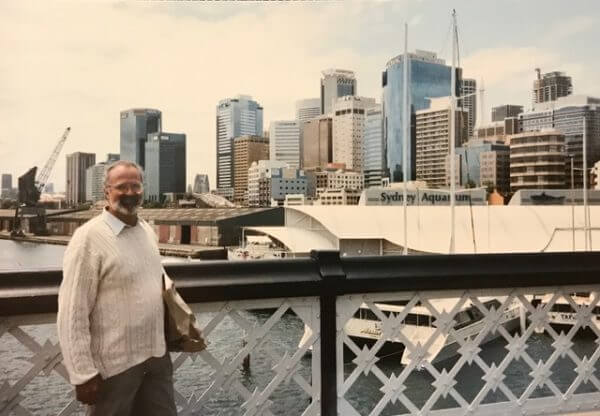 We did manage to have some fun once the conference was over. Michael Mann and a lovely fellow who had been deputed from the Foreign Ministry to be their on-site rep took us out to dinner in Chinatown one night and helped us arrange a thank-you-to-the-Lao-team dinner right on the harbor the next night. We went to Australia’s smash-hit movie, “Strictly Ballroom,” rode the monorail around the city by night and had a walking tour, thanks to the kindness of Michael and Jim.
We did manage to have some fun once the conference was over. Michael Mann and a lovely fellow who had been deputed from the Foreign Ministry to be their on-site rep took us out to dinner in Chinatown one night and helped us arrange a thank-you-to-the-Lao-team dinner right on the harbor the next night. We went to Australia’s smash-hit movie, “Strictly Ballroom,” rode the monorail around the city by night and had a walking tour, thanks to the kindness of Michael and Jim.
On Saturday, November 7, everyone went back to Laos (except for a small, high-ranking group of Lao who went on for official meetings in Canberra and tours of key industrial and mining sites elsewhere in Australia). Russell’s assistance was no longer needed, and he had use-it-or-lose-it vacation time, so we flew to Christchurch, New Zealand for one of the most wonderful vacations of our lives. We’re so high on New Zealand, we could be goodwill ambassadors for the country.
We had a fly-drive package, so we picked up our rental car at the airport and drove to the hotel where we would stay overnight. This is the only tourist-class hotel I ever saw which had free laundry facilities for guests and an iron and ironing board in the guest room! We got busy washing and ironing so we could be free to enjoy the rest of the stay. [An iron and ironing board in the room are standard now, but they sure weren’t back then.]
The next day, we walked around Christchurch. Nicknamed “The Garden City,” it surely is. Every house has a beautiful garden with flowering trees and shrubs, as well as herbaceous borders. In addition, there are many parks and public plantings throughout the city. It was springtime in New Zealand, and our first view was truly lovely.
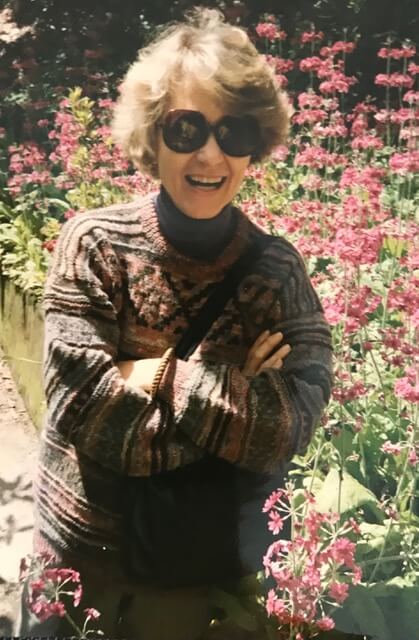 With great good fortune, we discovered an arts and crafts show at the art museum. We wandered around for several hours, looking at wood carving, woolen goods, pottery, fresh cheeses, clothing and I-don’t-know-what-all. We ended up buying a sweater apiece, some cheese for the road, and two wonderful, brightly colored felt hats. Even though it was springtime in New Zealand, it seemed quite chilly to our tropical blood, so we welcomed the warmth, as well as appreciating the beauty, of our woolen purchases.
With great good fortune, we discovered an arts and crafts show at the art museum. We wandered around for several hours, looking at wood carving, woolen goods, pottery, fresh cheeses, clothing and I-don’t-know-what-all. We ended up buying a sweater apiece, some cheese for the road, and two wonderful, brightly colored felt hats. Even though it was springtime in New Zealand, it seemed quite chilly to our tropical blood, so we welcomed the warmth, as well as appreciating the beauty, of our woolen purchases.
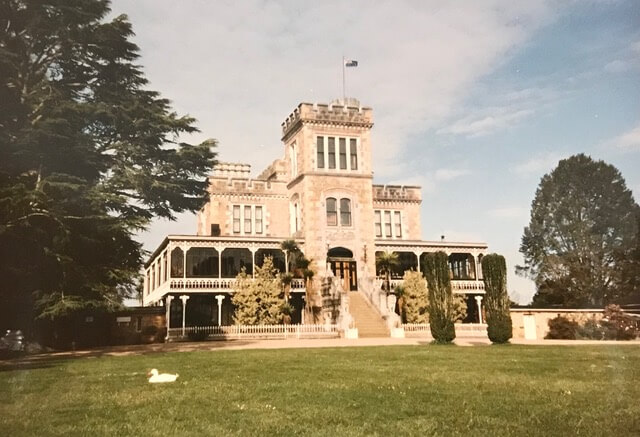 That afternoon, we drove to Dunedin (“doo-nee-din”), the oldest city in New Zealand, located at the end of a long, narrow harbor. We toured mansions built by gold and timber barons, drove out the length of the Otago Peninsula and rode in choppy waters to see the only colony of albatross that nests near humans. Every turn in the road found us exclaiming over delightful views.
That afternoon, we drove to Dunedin (“doo-nee-din”), the oldest city in New Zealand, located at the end of a long, narrow harbor. We toured mansions built by gold and timber barons, drove out the length of the Otago Peninsula and rode in choppy waters to see the only colony of albatross that nests near humans. Every turn in the road found us exclaiming over delightful views.
It’s truly a beautiful country — snow-capped mountains, steep-walled fiords, rolling green hills dotted with sheep, uncrowded and clean. No billboards, little traffic and some of the nicest people we’ve ever met. If it weren’t for the expanding ozone hole, we’d move there tomorrow and live there forever.
After two nights at a bed-and-breakfast in a large, art-nouveau house which had been built by one of New Zealand’s literati, we drove across the country to Manapouri [south of Te Anau on the map above] at the edge of Fiordland National Park. On the way, we had lunch at Gore, in what is reputed to be one of New Zealand’s finest restaurants. Unpretentious decor, thoughtful service and great food.
At Manapouri, we again stayed in a bed-and-breakfast, this time in an old inn which had been built by the present owner’s grandfather to entertain the gold and lumber barons when they’d come with vast families and stay several weeks. We only stayed two nights, but we had a nice time and great food — venison steaks one night, fresh salmon the next.
Although we took a two-hour hike on the evening of our arrival, our main destination in this region was Milford Sound [almost due west of Wanaka on the map above], which is not really a sound but a fiord. (Do you know the difference? I didn’t until I visited Milford. A sound is a deep chasm carved by a river, while a fiord is a deep chasm carved by a glacier.)
We drove from Manapouri along Te Anau Lake and up through the Homer Tunnel which cost so many men their lives over the decades it took to dig it, then down a steep and winding track to Milford Sound. The Tunnel is the only one I’ve seen of its kind — narrow, unpaved floor, sloping sharply downward toward the fiord, water dripping throughout its length, unlit, dark and eerie as if built by dwarves.
[New Zealand Director Peter Jackson later filmed “The Lord of the Rings” in his home country, and recollecting this trip, I could easily see why.]The drive itself was wondrous. You go through forests and along alpine meadows, past waterfalls, through many bands of vegetation until you’re above the snow line. Russell drove the tamer parts and kindly allowed this West Virginia girl to drive the mountain roads.
At the top of Milford Sound, we booked passage on a boat out to the Tasman Sea and back. After a short wait during which we had tea at the lodge, we boarded the boat for a glorious trip through our first fiord — high granite walls, snow-capped mountains, tall and narrow waterfalls, seals sunning on rocks, tree avalanches caused when the weight of the trees becomes too much for the thin soil on steep slopes and out to the rough sea, then back for a different perspective of the same views. The fiord is so deep that the QEII sails up to near the end, where the passage widens enough that they can turn that immense ship, just barely.
During our boat trip, we could hear and then see small planes which had been chartered by those intrepid enough to fly over the fiord or into the high country. When we returned, we met and talked with a helicopter pilot who flies supplies into remote locations. Then we watched him take off with the load slung beneath.
The following day, we drove through the central part of the country — much more sparse, drier and demanding, along river canyons where the ruins of goldmines still stand, through bleak passes not yet green with spring, to Geraldine [between Lake Tekapo and Timaru on the map above]. We stayed our last night in another bed-and-breakfast, this time the home of a former 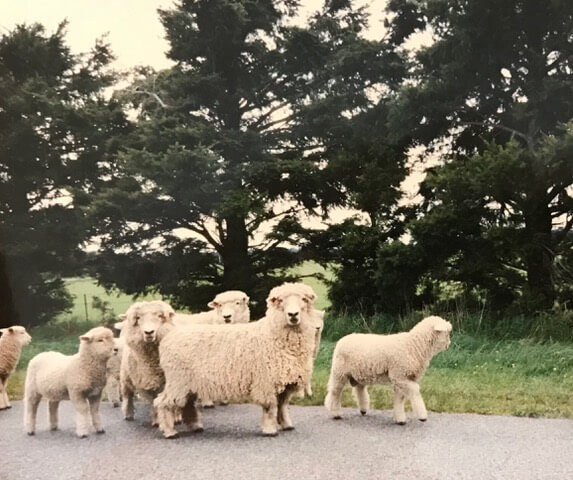 gentleman farmer, exposed beams and tile roofs surveying his domain.
gentleman farmer, exposed beams and tile roofs surveying his domain.
On Friday, the 13th, with some concern for the bad omen of the date, we drove the remaining miles into Christchurch and our return flight to Sydney. Rolling green sheep country again, a gentler landscape with garden-bordered cottages. At the end of the day, we found ourselves in the Sydney Airport Hotel, pleasantly tired and sure that we’d had one of the best trips we’ll ever have.
The next day, we took my bags into Sydney, did some shopping for a wedding present for the Lao lady who got married some letters before this one and saw some sights. We took the harbor cruise, ate seafood overlooking the water and toured the aquarium. Sydney is surely one of the nicest cities in the world. It’s a good size — you don’t feel overwhelmed; it has a wonderful geography around a multi-lobed harbor; and it has preserved the old while building some pretty good modern architecture.
We parted in the late afternoon, R to fly back to Bangkok and on to Vientiane the following day, me to take the train to Queensland and visit Clare Evenson. You may remember that Clare and I did the Guide last year. The ride up was a long one, but I wanted the chance to see more of Australia. All countries look alike from the air, but ground travel reveals the details. I left at 4:30 p.m. and had three hours of daylight to see lots of rivers and waterways and a deep canyon full of dark green trees. I arrived in Brisbane at 5:30 a.m., and there was Clare to meet me.
After breakfast at her hotel, we walked over to an Arts and Crafts Fair along the waterfront — two ladies in love with handicrafts. Clare got a super terra cotta city perched on a hill, about 8 inches high and pierced so you can put a candle under it. She used it as a centerpiece the following night, and I wished I’d figured out how to get one back to Laos.
We also managed to blunder into the Santa Claus parade, so we did our share of applauding from the sidelines as bands and floats and live reindeer (without reins!) went by. Then we drove two hours to Kin Kin in the afternoon. For those of you who want to look in the atlas, it’s so small, you probably won’t find it. It’s between Noosa Head on the coast [or Sunshine Coast on the map above] and Gympie.
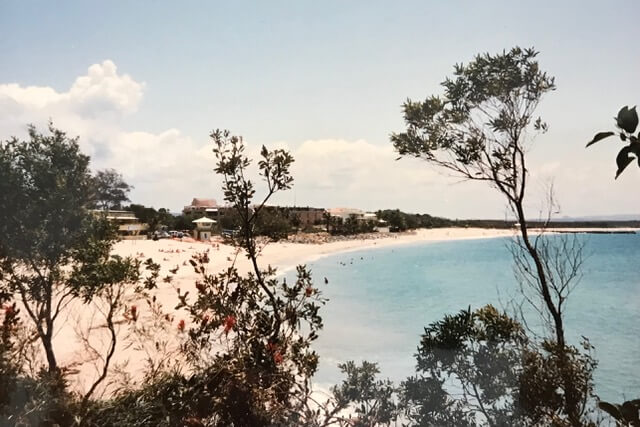 The next day, Monday, we went to Noosa Head, which is one of the best sea resorts I’ve ever seen — not too commercialized, a pretty town by the sea with some nice shops, not overdone — the way La Jolla used to be. We walked along the cliffs to a lovely little restaurant overlook-ing the sea, where we had nice food and good con-versation. The air was soft, and I could have stayed a long, long time.
The next day, Monday, we went to Noosa Head, which is one of the best sea resorts I’ve ever seen — not too commercialized, a pretty town by the sea with some nice shops, not overdone — the way La Jolla used to be. We walked along the cliffs to a lovely little restaurant overlook-ing the sea, where we had nice food and good con-versation. The air was soft, and I could have stayed a long, long time.
Back to Kin Kin and a small dinner party so I could meet Clare’s daughter, son-in-law and some local friends. The son-in-law is an Agentinian chef planning to open his own restaurant within the next year. The friends used to live in Kenya, so we got to practice our rusty Swahili for a few moments.
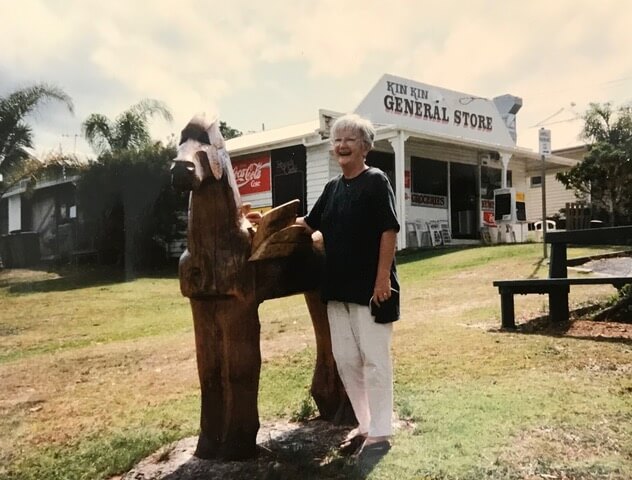 Tuesday was a quiet day. I was fighting a bit of a cold, so I mostly sat on the verandah, surveying the rolling hills, macadamia orchards and cattle while reading a book. We did go into Kin Kin — one pub, one country store, one post office, a few houses, a taste of old Australia. Outside Kin Kin is an old volcano plug which rises several hundred meters almost straight up. They have a yearly “Iron Man/Iron Woman” competition, and people run up it! Clare’s daughter is one of the competitors.
Tuesday was a quiet day. I was fighting a bit of a cold, so I mostly sat on the verandah, surveying the rolling hills, macadamia orchards and cattle while reading a book. We did go into Kin Kin — one pub, one country store, one post office, a few houses, a taste of old Australia. Outside Kin Kin is an old volcano plug which rises several hundred meters almost straight up. They have a yearly “Iron Man/Iron Woman” competition, and people run up it! Clare’s daughter is one of the competitors.
I was impressed with all the flood signs. Some distance back from every bridge are flood signs and gauges. When you get on the bridge, there’s a tiny little creek winding its way through a channel some 10 feet below the level of the land. When the rains come, it rises up out of its banks and buries the road in two meters of water, flooding the fields and farms and pubs and post offices for some distance around.
Fortunately, it didn’t flood while I was there, and I was able to get the airport bus the next day and fly out of Brisbane to Bangkok, making an unscheduled stop in Darwin because the re-fuelers were on strike in Brisbane. I arrived in Bangkok at midnight (3:00 a.m., Brisbane time), checked into the airport hotel and got up at 6:30 to fly standby to Vientiane. Fortunately, there was a no-show, and I got on the plane. We had several back-up plans if I didn’t make this fully-booked flight, but this time I got lucky. Khun Kham was there to meet the plane, and we drove to the office, picked up Russell and came home for Khetmanee’s special welcome-back lunch.

COMING NEXT MONTH
Touristing in Southeast Asia
Vietnam
As 1992 turned to 1993, we celebrated the New Year with Vientiane friends in Ho Chi Minh and Hanoi. Fascinating to experience another part of French Indochina in transition from war to peace.

LET ME HEAR FROM YOU.
Please take a moment to share your thoughts.
Your comments help make the blog better, and I always answer.
* * *
If you enjoyed reading this post, I hope you’ll SUBSCRIBE by clicking on the button below. Every month, when I post a new excerpt from my life overseas, you’ll get an email with a link so you can read the next installment. Subscription is free, and I won’t share your contact information with anyone else. Your subscribing lets me know you’re reading what I write, and that means a lot.

